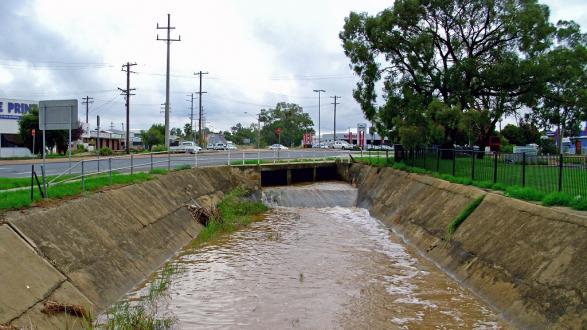Driving to my office during our recent rainstorms, I thought about the irony of the title of the song by Albert Hammond “It Never Rains in Southern California”—a very popular song in the 1970s.
Driving through puddles and flooded intersections and freeway lanes, clearly, we can see that it does indeed rain here in Southern California. So much so, it has been disheartening to see so much water go to waste, streaming into storm drains and then lost to the Pacific Ocean.
When much of our existing water infrastructure was established during the last century, it was not designed to capture stormwater for reuse purposes such as irrigation of our landscape or replenishment our aquifers. Our society had an “out of sight, out of mind” mindset for stormwater until we started to see the damage that trash and contaminants were causing as stormwater was swept to our beaches and waterways, threatening public health and our ecosystems.
We can potentially triple the amount of stormwater we currently capture by implementing a series of innovative stormwater projects and water system infrastructure improvements throughout the county that incorporate a combination of nature, science, and new technologies.
When innovators and early adopters of stormwater capture technology proposed the concept of stormwater capture as an important solution to address our water quality, water supply, and environmental and public health needs, naysayers cited Southern California’s seemingly perennial drought and pointed to the availability of plentiful water imported from other regions as the solution for Southern California’s water needs.
However, as the chorus of Mr. Hammond’s classic song states, “It pours, man, it pours.” We do indeed have rain here in sunny Southern California—a lot of it at times, despite the long periods of drought conditions we frequently experience. Rain that has so much potential, if only it could be effectively captured, cleaned, and stored to create a more sustainable Southern California.
As frustrating as it has been this past month seeing so much rain literally going “down the drain,” I am proud that the voters in Los Angeles County approved Measure W, the Safe Clean Water Parcel Tax, on the November 2018 ballot. This measure will provide greater water resiliency and an improved environment for Los Angeles County residents in this era of global warming.
By capturing, cleaning, recycling, and storing more stormwater, our region will benefit by having enhanced water quality, increased local water supplies, and a more sustainable future for our children and our grandchildren.
I am grateful that the county of Los Angeles, which provided the vision and leadership to put Measure W on the ballot, is promoting stormwater capture. And it is exciting to see that the concept of stormwater capture is being embraced by so many cities, agencies, NGOs, and community groups—and importantly, individual residents, who demonstrated their support by overwhelmingly approving Measure W.
According to the county, we can potentially triple the amount of stormwater we currently capture by implementing a series of innovative stormwater projects and water system infrastructure improvements throughout the county that incorporate a combination of nature, science, and new technologies.
By capturing, cleaning, recycling, and storing more stormwater, our region will benefit by having enhanced water quality, increased local water supplies, and a more sustainable future for our children and our grandchildren.
With more effective ways of capturing and cleaning stormwater, we will also see a significant reduction in the amount of trash and pollution that would otherwise contaminate our waterways, beaches, and the ocean.
With more effective ways of capturing and cleaning stormwater, we will also see a significant reduction in the amount of trash and pollution that would otherwise contaminate our waterways, beaches, and the ocean.
Dirty stormwater also tends to adversely affect many of our region’s low-income communities where parks, open space, and natural areas are scarce, and where flooding may be more likely to occur due to the presence of more impermeable surfaces.
Thankfully, many of the proposed stormwater capture projects currently being planned by such agencies as the county of Los Angeles, city of Los Angeles Bureau of Sanitation, and Los Angeles Department of Water & Power, are being developed from a multi-benefit perspective. These projects focus on nature-based green infrastructure opportunities that will improve water quality, augment local water supplies, and enhance—and even create more—green spaces throughout the county, including low-income and highly urbanized areas that lack parks, natural areas, and green spaces.
It is an exciting time in the water industry and for our region. As we approach the next decade of the 21st century, we are singing a new tune about water. All water is precious.
It is an exciting time in the water industry and for our region. As we approach the next decade of the 21st century, we are singing a new tune about water. All water is precious.
New technologies, new perspectives, and new realities—such as climate change and more extreme weather conditions—have led us to realize that stormwater capture is no longer just an option, but an essential element in our toolbox to create a more sustainable Los Angeles County.
Measure W will enable many projects to go forward by providing critical funding—funding that truly is an investment from the county’s residents who supported the parcel tax in anticipation of the societal benefits of implementing these new stormwater capture projects.
_______________________
Maria Mehranian is a Pacific Council member, the managing partner and chief financial officer of Cordoba Corporation, and a former member and chair of the Los Angeles Regional Water Quality Control Board. For information on the next steps for implementation of Measure W, visit safecleanwaterla.org.
This article was originally published by the Cordoba Corporation.
The views and opinions expressed here are those of the author and do not necessarily reflect the official policy or position of the Pacific Council.




